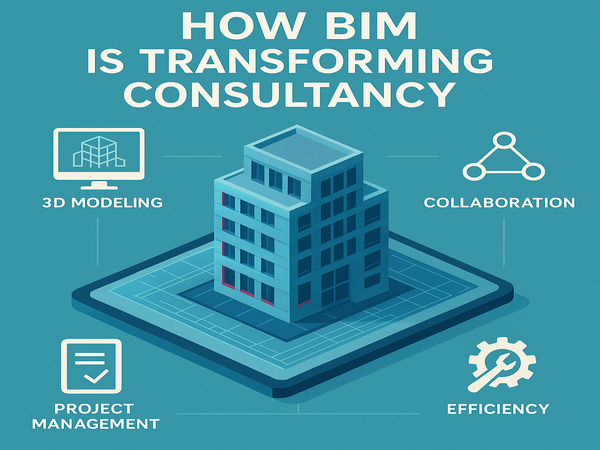The construction and design industries are experiencing a digital revolution, and at the heart of this transformation is Building Information Modeling. For consultancies, BIM is not just a new tool it’s a comprehensive process that is reshaping how projects are visualized, managed, and delivered. From improved collaboration to cost savings and risk reduction, Building Information Modeling is now central to the way consultants add value across the entire project lifecycle.
What is Building Information Modeling?
Building Information Modeling (BIM) is a digital process that creates a detailed, data-rich 3D model of a building’s physical and functional characteristics. Unlike traditional 2D drawings, BIM integrates every aspect of a project architecture, structure, MEP systems, and even scheduling and budgeting into a single, shared model. This model serves as a central source of truth for all stakeholders, including architects, engineers, contractors, and owners.
Enhanced Collaboration and Communication:-
One of the most significant ways Building Information Modeling is transforming consultancy is by breaking down silos. BIM enables real-time collaboration through a shared digital model, allowing consultants, clients, and contractors to work together seamlessly. This connectivity reduces misunderstandings, minimizes errors, and ensures everyone is working with the latest information. The result is fewer costly mistakes and faster decision-making.
Improved Visualization and Design Accuracy:-
Traditional design processes often rely on 2D drawings and manual cross-referencing, which can lead to misinterpretation and errors. With Building Information Modeling, consultants can visualize every aspect of a project in 3D, making it easier to spot design conflicts and optimize solutions before construction begins. Laser scans and digital imagery can be integrated into the BIM model, providing a true-to-life representation of existing conditions and proposed changes.
Proactive Clash Detection and Risk Reduction:-
BIM’s advanced clash detection capabilities allow consultants to identify and resolve design conflicts early in the planning phase. By running automated checks on the digital model, consultants can catch issues such as overlapping pipes or structural conflicts before they become costly problems on site. This proactive approach reduces rework, keeps projects on schedule, and minimizes financial risk.
Streamlined Project Lifecycle Management:-
Building Information Modeling streamlines every stage of a project, from initial planning to facility management. Consultants use BIM to coordinate schedules, manage costs, and track progress in real time. The model can be linked to construction timelines (4D) and budgets (5D), enabling more accurate forecasting and resource allocation. After construction, BIM continues to add value by supporting maintenance, renovations, and even demolition through its detailed asset data.
Greater Cost Predictability and Efficiency:-
BIM empowers consultants to generate precise quantity takeoffs and cost estimates directly from the model. This accuracy helps clients avoid budget surprises and enables consultants to recommend cost-effective solutions early in the design process. According to industry studies, BIM can reduce unbudgeted changes by up to 40% and cut project time by as much as 7%.
Quality Assurance and Model Audits:-
Consultancies leverage Building Information Modeling to perform regular model audits, ensuring data accuracy, compliance with standards, and consistency across all project elements. These quality checks help maintain high standards and reduce the risk of errors making it to the construction phase.

Better Facility Management and Lifecycle Value:-
The benefits of Building Information Modeling extend well beyond construction. Facility managers use BIM data for ongoing maintenance, space planning, and future upgrades. Consultants can provide clients with a comprehensive digital record of their building, supporting efficient operations and long-term asset management.
The Role of BIM Consultants:-
BIM consultants specialize in implementing and optimizing BIM processes for architecture, engineering, and construction (AEC) firms. Their services include:
- BIM management and coordination
- 3D modeling and visualization
- Clash detection and risk analysis
- Model audits and quality control
- Content and template creation for standardized workflows
- Digital engineering to bridge design and construction
By guiding clients through BIM adoption, consultants help streamline workflows, reduce risk, and ensure project success.

Future Trends: Where is Building Information Modeling Taking Consultancy?
As technology evolves, Building Information Modeling is set to become even more integral to consultancy. The integration of artificial intelligence, IoT sensors, and real-time data analytics will further enhance BIM’s capabilities, enabling predictive maintenance, energy optimization, and smarter buildings. Consultants who embrace these innovations will continue to lead the industry in delivering value to clients.
FAQs:-
Q1: How does Building Information Modeling improve project collaboration?
A: BIM provides a shared digital model that all stakeholders can access and update in real time, improving communication and reducing errors.
Q2: What are the main benefits of BIM for consultancy firms?
A: BIM enhances design accuracy, streamlines workflows, reduces risk, improves cost estimation, and supports better facility management.
Q3: Can BIM be used after construction is complete?
A: Yes, BIM supports facility management, maintenance, renovations, and even demolition by providing a comprehensive digital record of the building.
Q4: What is clash detection in BIM?
A: Clash detection is the process of identifying and resolving design conflicts within the BIM model before construction begins, reducing costly rework.
Q5: Why should clients hire a BIM consultant?
A: BIM consultants help implement BIM processes, ensure data accuracy, optimize workflows, and maximize the value of BIM throughout the project lifecycle.
Conclusion:-
Building Information Modeling is fundamentally transforming consultancy by enhancing collaboration, improving accuracy, reducing risk, and delivering better outcomes for clients. As BIM continues to evolve, consultancies that embrace this technology will be well-positioned to lead the industry, drive innovation, and deliver lasting value on every project.
Read More On:-
For more information about engineering, architecture, and the building & construction sector, go through the posts related to the same topic on the Specuwin Blog Page.
Find out more accurately what we are going to take off in the course of applying leading new technologies and urban design at Specuwin.
